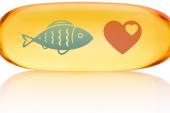New STRENGTH Analysis Revives Omega-3 Debate
“We think there remains a lot of uncertainty whether these omega-3 fatty acids actually benefit patients,” Steven Nissen says.

STRENGTH failed to show that an omega-3 carboxylic acid formulation containing both eicosapentaenoic acid (EPA) and docosahexaenoic acid (DHA)—called Epanova (AstraZeneca)—reduces cardiovascular events in patients with elevated triglycerides and low HDL cholesterol. When the results were released in November 2020, Steven Nissen, MD (Cleveland Clinic, OH), chair of the trial’s executive committee, said that indicated that the REDUCE-IT trial—which had success with icosapent ethyl (Vascepa; Amarin), an omega-3 formulation containing purified EPA—was “a false-positive result.”
Reasons put forward to explain the discrepant findings were differences in placebo, with REDUCE-IT using a mineral oil placebo associated with some risk and STRENGTH using a more-neutral corn oil placebo; higher achieved EPA levels in REDUCE-IT; and possible harm from the DHA included in the agent tested in STRENGTH.
This past weekend, at the virtual American College of Cardiology (ACC) 2021 Scientific Session, Nissen presented results from a post hoc analysis of STRENGTH to address the latter two possibilities, demonstrating that MACE risk was not reduced among patients with the highest plasma EPA levels at 1 year or worsened among those with the highest plasma DHA levels.
In the context of the increased risk of atrial fibrillation seen in STRENGTH, REDUCE-IT, and other fish oil trials, Nissen argued that it’s not clear whether any omega-3 fatty acid treatment improves outcomes for patients, calling for more research to compare the effects of mineral oil versus corn oil and to compare purified EPA with other omega-3 fatty acid formulations.
“It is our belief that the reason that STRENGTH and REDUCE-IT showed different results is we had different comparators,” Nissen reiterated during a press briefing at ACC. “Corn oil was neutral, and there was lots of evidence that mineral oil was not neutral but in fact it increased cardiovascular events. So we think there remains a lot of uncertainty whether these omega-3 fatty acids actually benefit patients.”
Big Increases in EPA, With No Effects
For the post hoc STRENGTH analysis, published simultaneously online in JAMA Cardiology, the investigators examined data on 10,382 trial participants who had information available on EPA and DHA levels at 1 year. They divided actively treated patients into tertiles of achieved omega-3 fatty acid levels.
Baseline characteristics were generally similar across tertiles and the placebo group. Lipid measurements were largely similar, as well, except that active treatment reduced triglycerides by about 19%, Nissen reported.
At 12 months, the median plasma EPA level in the top tertile was 151 µg/mL, a 443% increase from baseline. The median plasma DHA level was 118 µg/mL, a 68% increase.
There was no relationship between MACE and the top tertile of either achieved EPA (adjusted HR 0.98; 95% CI 0.83-1.16) or achieved DHA (adjusted HR 1.02; 95% CI 0.86-1.20). Likewise, there were no significant relationships when looking at changes in plasma EPA or DHA, or achieved levels or changes in red blood cell EPA or DHA.
Nissen acknowledged some limitations of this analysis, including the post hoc nature, which means it should be considered exploratory and hypothesis-generating. In addition, there was moderate correlation between EPA and DHA levels, complicating independent assessment of how each fatty acid is related to clinical outcomes, he said.
Nevertheless, Nissen maintained that these results indicate that it’s not clear whether there was actually a benefit in REDUCE-IT, especially considering that there are several other neutral trials in this space. “Under those circumstances, I cannot recommend giving these drugs, particularly given the rather substantial increase in atrial fibrillation, so I think we need more trials to answer the question,” he stressed. “Replication is important in the world of clinical trials, and the problem is that STRENGTH doesn’t replicate the results of REDUCE-IT.”
‘Proof Is in the Pudding’
Michael Miller, MD (University of Maryland School of Medicine, Baltimore), a member of the REDUCE-IT steering committee, latched onto the difficulty in separating the effects of EPA from those of DHA in STRENGTH when explaining the disparate findings of STRENGTH and REDUCE-IT. “You can’t disentangle DHA from EPA because they were correlated, and so you lose some of the robust effect of EPA-only studies,” Miller explained.
He pointed to research indicating that DHA has adverse effects on cell membranes and suggesting that it can have prooxidant and proinflammatory effects to explain why the inclusion of DHA could be a problem.
Miller, a member of the ACC Prevention Nutrition & Lifestyle Work Group, also pushed back against Nissen’s contention that the findings of REDUCE-IT don’t have support from other trials. JELIS, he noted, also showed that icosapent ethyl reduced cardiovascular events in patients with hypercholesterolemia. In addition, angiographic studies like EVAPORATE show that the drug slows the progression of atherosclerosis. “When you introduce DHA into the mix, you appear to lose that effect,” Miller said.
His takeaway for practicing physicians trying to decide whether to use an omega-3 fatty acid therapy for their patients is that “the proof is in the pudding. . . . As a clinician I’m going to continue to use what works.” Until the effects of EPA and DHA can be disentangled, he added, “I’m going to go with the evidence, and the evidence today is with purified EPA, such as icosapent ethyl.”
Bhatt said that even though STRENGTH didn’t show a relationship between omega-3 fatty acid levels and ischemic events, “one could just conclude that the absence of a relationship in a negative trial doesn’t tell us that much other than the specific drug studied didn’t work.”
Todd Neale is the Associate News Editor for TCTMD and a Senior Medical Journalist. He got his start in journalism at …
Read Full BioSources
Nissen SE, Lincoff AM, Wolski K, et al. Association between achieved ω-3 fatty acid levels and major adverse cardiovascular outcomes in patients with high cardiovascular risk: a secondary analysis of the STRENGTH trial. JAMA Cardiol. 2021;Epub ahead of print.
Disclosures
- The STRENGTH trial was funded by AstraZeneca.
- Nissen reports receiving grants from AstraZeneca during the conduct of the study and performing clinical trials for AbbVie, Amgen, AstraZeneca, Esperion, Eli Lilly, Novartis, Takeda, Resverlogix, Orexigen , Ethicon Endosurgery, Medtronic, The Medicines Company, and Pfizer. The companies are directed to pay any honoraria or speaking/consulting fees directly to charity so that neither income nor a tax deduction is received.
- Miller reports being a member of the REDUCE-IT steering committee and being an advisor for Pfizer.
- Bhatt reports receiving research funding or unfunded research support from Abbott, Amarin, Amgen, AstraZeneca, Bayer, Boehringer Ingelheim, Bristol-Myers Squibb, Chiesi, Eisai, Ethicon, Forest Laboratories, Idorsia, Ironwood, Ischemix, Lilly, Medtronic, PhaseBio, Pfizer, Regeneron, Roche, Sanofi, Synaptic, The Medicines Company, FlowCo, Merck, Novo Nordisk, PLx Pharma, and Takeda; being a site co-investigator for Biotronik, Boston Scientific, St. Jude Medical, and Svelte; being a trustee for ACC; serving as an advisory board member, director, or chair for Cardax, Elsevier Practice Update Cardiology, Medscape Cardiology, Regado Biosciences; the Boston VA Research Institute, the Society of Cardiovascular Patient Care, TobeSoft; the American Heart Association Quality Oversight Committee; serving on a range of data safety monitoring committees; receiving honoraria for editorial or committee activities for a range of publications and organizations; and receiving royalties from Elsevier.





Comments